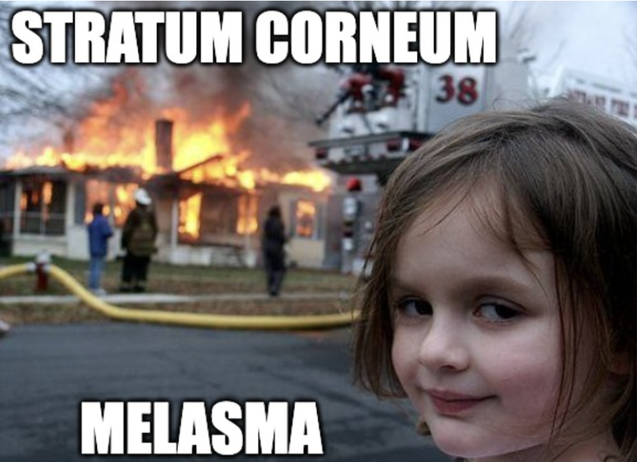THIRTY-FifTH ISSUE
May 31, 2023
Autoimmune, Inflammatory, Atopic, Thyroid, and Psychiatric Outcomes of Offspring Born to Mothers With Alopecia Areata
JAMA Dermatology
Autoimmune, Inflammatory, Atopic, Thyroid, and Psychiatric Outcomes of Offspring Born to Mothers With Alopecia Areata
JAMA Dermatology
If clinicians are unaware of risks associated with maternal alopecia areata, it's hair loss!
Like other autoimmune conditions, alopecia areata (AA), a chronic autoimmune disorder that causes nonscarring hair loss, is associated with multiple other autoimmune and inflammatory diseases due to immune dysregulation. Data regarding the risk that these disorders can be passed to offspring of mothers with AA is lacking. This retrospective, Korean population-based cohort study compared 67,364 children born to mothers with AA and 673,640 controls born to mothers without AA to investigate risk of comorbidities associated with AA using adjusted hazard ratio (aHR).
What did they find?
Limitations: This study was performed in a single ethnicity cohort, which may limit generalizability of the findings. This study also lacks paternal information, which may confound the results.
Main Takeaway: Children born to mothers with AA are likely to be at an increased risk of AA, vitiligo, atopic disorders, hypothyroidism, and psychiatric disorders. Clinicians and parents should have a high index of suspicion for symptoms of these conditions.
Like other autoimmune conditions, alopecia areata (AA), a chronic autoimmune disorder that causes nonscarring hair loss, is associated with multiple other autoimmune and inflammatory diseases due to immune dysregulation. Data regarding the risk that these disorders can be passed to offspring of mothers with AA is lacking. This retrospective, Korean population-based cohort study compared 67,364 children born to mothers with AA and 673,640 controls born to mothers without AA to investigate risk of comorbidities associated with AA using adjusted hazard ratio (aHR).
What did they find?
- Among offspring born to mothers with AA, there was a significantly increased risk of:
- AA, aHR 2.08; 95% CI, 1.88-2.30
- Alopecia totalis/alopecia universalis (AT/AU), aHR 1.57; 95% CI, 1.18-2.08
- Vitiligo, aHR 1.47; 95% CI, 1.32-1.63
- Atopic disorders, aHR 1.07; 95% CI, 1.06-1.09
- Hypothyroidism, aHR 1.14; 95% CI, 1.03-1.25
- Psychiatric disorders, aHR 1.15; 95% CI, 1.11-1.20
- Offspring born to mothers with alopecia totalis (AT)/alopecia universalis (AU) were at much higher risk for both AT/AU (aHR 2.98; 95% CI, 1.48-6.00) and psychiatric disease (aHR 1.27; 95% CI, 1.12-1.44)
Limitations: This study was performed in a single ethnicity cohort, which may limit generalizability of the findings. This study also lacks paternal information, which may confound the results.
Main Takeaway: Children born to mothers with AA are likely to be at an increased risk of AA, vitiligo, atopic disorders, hypothyroidism, and psychiatric disorders. Clinicians and parents should have a high index of suspicion for symptoms of these conditions.
Is one surgical treatment for microcystic adnexal carcinoma better than another?
Dermatologic Surgery
Scrap that MAC!
Microcystic adnexal carcinoma (MAC) is a slow growing but locally aggressive cutaneous neoplasm that requires complete excision with either Mohs micrographic surgery (MMS) or wide local excision (WLE). This 27 year retrospective cohort study reviewed electronic medical health records to compare tumor characteristics and outcomes of 69 MACs that were treated either with MMS (n=34) or WLE (n=35). Outcome measures included tumor margin status and development of local recurrence or nodal/distant metastases.
What did they find?
Limitations: Data was collected from the electronic medical records from a single institution, resulting in potentially poor generalizability, data quality, and standardization.
Main takeaways: MMS was superior to WLE for the treatment of microcystic adnexal carcinoma due to improved margin control.
Microcystic adnexal carcinoma (MAC) is a slow growing but locally aggressive cutaneous neoplasm that requires complete excision with either Mohs micrographic surgery (MMS) or wide local excision (WLE). This 27 year retrospective cohort study reviewed electronic medical health records to compare tumor characteristics and outcomes of 69 MACs that were treated either with MMS (n=34) or WLE (n=35). Outcome measures included tumor margin status and development of local recurrence or nodal/distant metastases.
What did they find?
- There were no significant differences in preoperative size or depth of invasion between the two cohorts
- After the first surgical attempt, 21 (60%) of the WLE treated MACs had positive margins; while 100% of the MMS treated MACs had negative margins (p < 0.01)
- Of the 21 WLEs with positive margins, 9 achieved negative margins after additional re-excision(s) ± adjuvant chemotherapy/radiation; 4 had residual positive margins after additional re-excision(s) ± adjuvant chemotherapy/radiation; 1 had residual positive margins after radiation; and additional treatment after initial WLE of 7 MACs is unknown
Limitations: Data was collected from the electronic medical records from a single institution, resulting in potentially poor generalizability, data quality, and standardization.
Main takeaways: MMS was superior to WLE for the treatment of microcystic adnexal carcinoma due to improved margin control.
How is synthetic photostable retinoid EC23 involved in the regulation of epidermal proliferation and hair follicle cycling?
Journal of Cosmetic Dermatology
Don't Avoid the Synthetic Retinoids!
Natural retinoids are vitamin A derivatives that are important regulators of the skin. While they increase cell proliferation and turnover, they typically lack photostability. As such, the development of more stable synthetic retinoids, like EC23, has flourished. Researchers compared the roles of EC23 with ATRA (a bioactive retinoid) using various models, including monolayer keratinocytes, in vitro human epidermal equivalents, and mouse models.
What did they find?
Limitations: Only one type of synthetic retinoid was used in this study so results may not be generalizable to all synthetic retinoids in development.
Main takeaway: EC23 synthetic photostable retinoid has a more potent effect on epidermal proliferation and skin physiology compared to the natural retinoid ATRA.
Natural retinoids are vitamin A derivatives that are important regulators of the skin. While they increase cell proliferation and turnover, they typically lack photostability. As such, the development of more stable synthetic retinoids, like EC23, has flourished. Researchers compared the roles of EC23 with ATRA (a bioactive retinoid) using various models, including monolayer keratinocytes, in vitro human epidermal equivalents, and mouse models.
What did they find?
- EC23 showed increased expression of epidermal proliferation marker Ki67 in cultured keratinocytes compared to ATRA (p<0.05)
- While EC23 and ATRA both increased epidermal thickness in a dose-dependent effect, EC23 did so to a greater degree when treated with the same dose (p< 0.001)
- EC23 treated models contained more keratin-14 positive layers, fewer keratin-10 positive layers, and little filaggrin staining
- Epidermal thickening on mice was threefold greater with EC23 therapy (p< 0.0001)
- Mice treated with EC23 exhibited more robust hair re-growth and anagen hair follicles
Limitations: Only one type of synthetic retinoid was used in this study so results may not be generalizable to all synthetic retinoids in development.
Main takeaway: EC23 synthetic photostable retinoid has a more potent effect on epidermal proliferation and skin physiology compared to the natural retinoid ATRA.
Skin barrier function and its relationship with IL-17, IL-33, and filaggrin in malar melasma
American Journal of Dermatopathology
IL-17 is not cytoKIND in melasma
While the mechanism of melasma, a disorder of pigmentation that presents with recurrent hyperpigmentation of sun-exposed skin, has yet to be fully elucidated, damage to the stratum corneum and barrier recovery rate have been implicated. The protein filaggrin (FLG), cleaved from its precursor profilaggrin during keratinocyte differentiation, plays a critical role in skin barrier function. Because the proinflammatory cytokine IL-17 directly regulates FLG, researchers were curious if IL-17 played a role in the pathogenesis of melasma. In this study, biopsies of malar and unaffected perilesional skin were taken from 20 female participants with untreated melasma; samples were compared to 10 age-matched controls.
What did they find?
Limitations: The findings of this study are not generalizable due to the small sample size of this single-center study.
Main takeaways: Proinflammatory cytokine IL-17 may influence abnormal epidermal differentiation in melasma, leading to diminished skin barrier integrity and delayed recovery time.
While the mechanism of melasma, a disorder of pigmentation that presents with recurrent hyperpigmentation of sun-exposed skin, has yet to be fully elucidated, damage to the stratum corneum and barrier recovery rate have been implicated. The protein filaggrin (FLG), cleaved from its precursor profilaggrin during keratinocyte differentiation, plays a critical role in skin barrier function. Because the proinflammatory cytokine IL-17 directly regulates FLG, researchers were curious if IL-17 played a role in the pathogenesis of melasma. In this study, biopsies of malar and unaffected perilesional skin were taken from 20 female participants with untreated melasma; samples were compared to 10 age-matched controls.
What did they find?
- On immunohistochemistry, FLG stained significantly darker in the epidermis of melasma skin compared to unaffected perilesional and control skin (p=0.001), suggesting augmentation of FLG in melasma
- Expression of IL-17 (p=0.03) and profilaggrin (P=0.001) was significantly higher in melasma lesions compared to unaffected perilesional skin and controls
- While transepidermal water loss decreased in both unaffected perilesional skin and melasma skin after skin perturbation, it occurred to a lesser extent in melasma skin (p=0.01), supporting the hypothesis of a delayed skin barrier recovery rate in melasma
- IL-17 and profilaggrin expression were positively associated in melasma lesions after skin barrier perturbance (p=0.03), suggesting a mechanism for delayed skin barrier recovery rate
Limitations: The findings of this study are not generalizable due to the small sample size of this single-center study.
Main takeaways: Proinflammatory cytokine IL-17 may influence abnormal epidermal differentiation in melasma, leading to diminished skin barrier integrity and delayed recovery time.
Dermatologic findings and characteristics of 101 mpox cases from the 2022 global outbreak
Journal of the American Academy of Dermatology
Characteristics of the newest species of m~pox~!
Despite 79,000 reported global cases of mpox (previously called monkeypox) in 2022, limited data regarding dermatologic lesions associated with the virus has been published. Using 101 cases reported via a global registry, researchers aimed to characterize mpox lesion morphology, symptomatology, and outcomes.
What did they find?
General
Limitations: Registry-reported data may favor more clinically severe cases and thus findings may be skewed.
Main takeaway: The initial presentation of mpox is often cutaneous (54%), with most (98%) patients presenting with cutaneous manifestations over the course of the virus. Familiarity with common lesion characteristics and morphology can aid in better recognition and management of this disease.
Despite 79,000 reported global cases of mpox (previously called monkeypox) in 2022, limited data regarding dermatologic lesions associated with the virus has been published. Using 101 cases reported via a global registry, researchers aimed to characterize mpox lesion morphology, symptomatology, and outcomes.
What did they find?
General
- 98% of reported cases occurred in gay or bisexual men (median age 35)
- Over half (54%) of cases reported skin lesions or rash as the first sign of infection, with 44% occurring in the genito-inguinal area, 26% in the peri-anal/anal area, and 21% on the face/lips
- 85% of patients reported skin lesions within the first 3 days of signs/symptoms
- 98% of patients reported skin lesions or rash during the course of illness
- 52% of patients presented with 2-5 lesions at symptom onset
- 38% of patients reported between 6-25 total number of lesions throughout the duration of infection, with 29% reporting between 2 and 5
- During days 1-5, most cases exhibited papules (36%), pustules (20%), and vesicles (17%)
- Progression to days 6-10 saw pustules (36%) become the most prevalent followed by erosions/ulcers (27%), and crusts/scabs (24%)
- After day 11, crusts/scabs emerged as the predominate morphology
- The median time to lesion resolution was 20 days; 13% of patients experienced residual scarring
Limitations: Registry-reported data may favor more clinically severe cases and thus findings may be skewed.
Main takeaway: The initial presentation of mpox is often cutaneous (54%), with most (98%) patients presenting with cutaneous manifestations over the course of the virus. Familiarity with common lesion characteristics and morphology can aid in better recognition and management of this disease.





